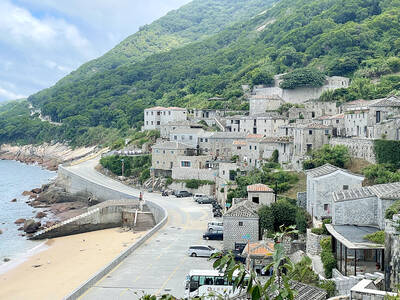A man with a black belt in taekwondo who wanted to be a police officer was disqualified because he was 1cm shorter than the required height for police academy candidates.
Lin Shih-hao (林士豪), a Taipei resident, passed the special entrance for the Taiwan Police Academy in 2011. However, when he reported for training in February last year, school officials ordered him to have his height measured at the Taipei Wanfang Hospital.
After a hospital report established that Lin was 1.64m tall, he was dismissed as ineligible to join the force because of the requirement that male candidates be 1.65m tall, which is stipulated in Article 8 of the academy’s regulations.
Lin was upset by his disqualification and filed a lawsuit last year under the Administrative Appeals Act (行政訴訟法).
Lin, who says he has a black belt certification from the World Taekwondo Headquarters in South Korea, said that the ability to carry out police work depends on physical fitness and maximizing one’s strength, and as such height and body size are not decisive factors.
“I have a black belt in taekwondo and I am certainly fit enough for police work and could handle criminals,” Lin said.
“For police to enforce the law and to protect society, is a height requirement really that important?” he asked, adding that for many police duties such as forensics and traffic control, an officer’s stature is not an essential element.
He said that while some Asian countries have minimum-height requirements for police officers, in Japan it is 1.6m for men and in Hong Kong it is 1.63m.
In response, an official from the Civil Service Protection and Training Commission said that the police are responsible for law and order, and therefore must have the required physique and fitness.
“Police are gun-carrying civil servants,” and so their work is quite different from that of regular state employees, he said, adding that this allowed for “different treatment and requirements.”
As such, a minimum height requirement for police officers is not a violation of the equal rights enshrined in the Constitution.
The ruling by the Taipei High Administrative Court stated that police work is of a special nature, and that an officer’s height is an important criterion.
An official from the National Police Agency said that the minimum height requirements of 1.65m for men and 1.6m for women had been in place for at least 30 years and are based on a national survey of average heights carried out by the Department of Health at the time the rules were enacted.
“The height requirements were based on police officers having to manhandle criminals, and being able to hold up riot shields when on crowd control duty at mass gatherings. Officers can only enforce law and order effectively with a suitable physique and level of fitness, leaving the public feeling safe and well protected. Therefore it is absolutely necessary for height and fitness requirements,” the official said.
A police officer surnamed Lee (李) added: “Rules are rules. I do not agree that exceptions should be made or else things will go out of whack.”
“If an officer is too short, then petty criminals and gangsters might feel they can look down on you. Also we have to carry a gun in the holster, which is a part of the police uniform, so it has to look right. The military also has height requirements,” Lee added.
Additional reporting by Huang Tun-yen

The first two F-16V Bock 70 jets purchased from the US are expected to arrive in Taiwan around Double Ten National Day, which is on Oct. 10, a military source said yesterday. Of the 66 F-16V Block 70 jets purchased from the US, the first completed production in March, the source said, adding that since then three jets have been produced per month. Although there were reports of engine defects, the issue has been resolved, they said. After the jets arrive in Taiwan, they must first pass testing by the air force before they would officially become Taiwan’s property, they said. The air force

GLOBAL: Although Matsu has limited capacity for large numbers of domestic tourists, it would be a great high-end destination for international travelers, an official said Lienchiang County’s (Matsu) unique landscape and Cold War history give it great potential to be marketed as a destination for international travelers, Tourism Administration Director General Chen Yu-hsiu (陳玉秀) said at the weekend. Tourism officials traveled to the outlying island for the Matsu Biennial, an art festival that started on Friday to celebrate Matsu’s culture, history and landscape. Travelers to Matsu, which lies about 190km northwest of Taipei, must fly or take the state-run New Taima passenger ship. However, flights are often canceled during fog season from April to June. Chen spoke about her vision to promote Matsu as a tourist attraction in

PAWSITIVE IMPACT: A shop owner said that while he adopted cats to take care of rodents, they have also attracted younger visitors who also buy his dried goods In Taipei’s Dadaocheng (大稻埕), cats lounging in shops along Dihua Street do more than nap amid the scent of dried seafood. Many have become beloved fixtures who double as photography models, attracting visitors and helping boost sales in one of the capital’s most historic quarters. A recent photo contest featuring more than a dozen shop cats drew more than 2,200 submissions, turning everyday cat-spotting into a friendly competition that attracted amateur and professional photographers. “It’s rare to see cats standing, so when it suddenly did, it felt like a lucky cat,” said Sabrina Hsu (徐淳蔚), who won the NT$10,000 top prize in

STRIKE: Some travel agencies in Taiwan said that they were aware of the situation in South Korea, and that group tours to the country were proceeding as planned A planned strike by airport personnel in South Korea has not affected group tours to the country from Taiwan, travel agencies said yesterday. They added that they were closely monitoring the situation. Personnel at 15 airports, including Seoul’s Incheon and Gimpo airports, are to go on strike. They announced at a news conference on Tuesday that the strike would begin on Friday next week and continue until the Mid-Autumn Festival next month. Some travel agencies in Taiwan, including Cola Tour, Lion Travel, SET Tour and ezTravel, said that they were aware of the situation in South Korea, and that group